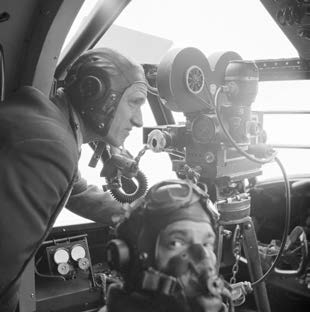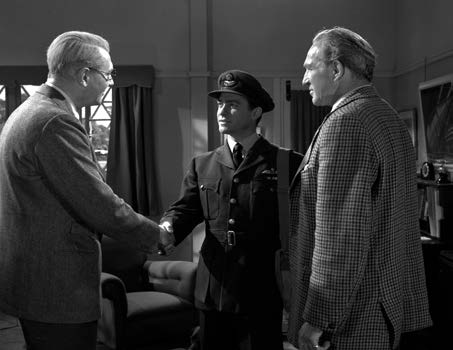Author Jonathan Falconer details the extraordinary achievement of the Dam Busters filmmakers in bringing to life the famous mission in the dangerous aerial sequences
Making The Dam Busters
The Aerial Filming
by Jonathan Falconer
For many cinemagoers, The Dam Busters is probably the best-known and loved British war film of the post-Second World War era. It is based on dam-buster leader Wing Commander Guy Gibson’s own account in Enemy Coast Ahead (1944) and the best-selling book The Dam Busters (1951) by a young Australian newspaper journalist-turned-author named Paul Brickhill. Directed by Michael Anderson, the 1955 docu-drama with its screenplay by the famous British playwright R.C. Sherriff (author of Journey’s End) recreates the tension and bravery of 617 Squadron’s audacious raid on Nazi Germany’s Ruhr dams on 16/17 May 1943.
Combining the quintessentially British qualities of inventiveness and dogged determination, the film is split into two distinct sections. The first deals with the fraught but ultimately successful development of Barnes Wallis’s revolutionary bouncing bomb; the second deals with the raid itself and its subsequent impact on both the enemy and the airmen of 617 Squadron. Without falling into the traps of jingoism or sentimentality, Anderson’s film celebrates the RAF’s unsung heroes of the Second World War while at the same time highlighting Britain’s tendency to stifle genius. The result is among the finest war films ever made.
In the 60 or more years since The Dam Busters was premiered in 1955 at the Empire, Leicester Square, in London’s West End, surprisingly little has been written or published about the film, and in particular how and by whom the complex aerial filming work was carried out. This is all the more surprising given that the dramatic flying sequences, meticulously planned and stunningly photographed by the Director of Photography Erwin Hillier and Special Effects Photographer Gilbert Taylor, are central to the film’s appeal. Arguably, they are up there with the very best war films featuring combat aircraft like Tora! Tora! Tora! and Top Gun.
The process of filming three Lancaster bombers flying together in tight formation at low level, from a fourth aircraft, and often over water, is in itself a dangerous activity requiring the steady hands and keen eyes of film professionals. Those RAF aircrew who skilfully flew the venerable Lancasters on camera deserve credit for their superb feats of airmanship that have brought alive the epic story of the dam busters to millions of viewers down the years. At the time they never received so much as a screen credit for their part in the film, although the assistance of the Air Ministry and the RAF was duly acknowledged. These aircrew are the unsung stars of the film and deserve some measure of recognition alongside the memorable performances of Richard Todd and Michael Redgrave.
Film-maker Associated British needed Avro Lancaster bombers and pilots who could fly them, but the venerable ‘Lanc’ had been withdrawn from RAF frontline service in 1950 to be replaced by its larger and more powerful lookalike, the Lincoln. Being a development of the Lancaster, the Lincoln had many characteristics in common so it was logical that its pilots would be the obvious choice to crew the Lancasters for the film.
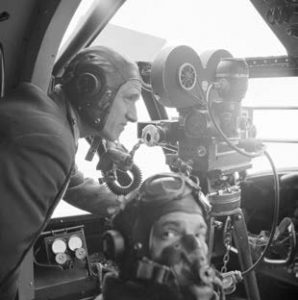 For many people, the stars of the film are undoubtedly the Lancasters themselves, yet it is hard to believe that only 9 years after the end of the Second World War these aircraft were in short supply when the filming commenced in April 1954. Four Mk 7 aircraft were taken out of storage at 20 Maintenance Unit, RAF Aston Down, and specially modified for the film.
For many people, the stars of the film are undoubtedly the Lancasters themselves, yet it is hard to believe that only 9 years after the end of the Second World War these aircraft were in short supply when the filming commenced in April 1954. Four Mk 7 aircraft were taken out of storage at 20 Maintenance Unit, RAF Aston Down, and specially modified for the film.
These were NX673, NX679, NX782 and RT686. In fact, ’673, ’679 and ’782 had already developed a taste for the movies because they had recently appeared in Philip Leacock’s feature film about a wartime Lancaster squadron, Appointment in London (1953), starring Dirk Bogarde.
Four operational Lincoln crews from 83 and 97 Squadrons at nearby RAF Hemswell were picked to fly the Lancasters on camera. Most of these men were fresh from a four-month detachment to Singapore where they had flown air strikes against Communist terrorists in Malaya. They were led by Flt Lt Ken Souter, a flight commander on 83 Squadron, who was ably supported by pilots Flt Sgt Joe Kmiecik AFM (83 Squadron), and Flg Off Dick Lambert and Flt Sgt Ted Szuwalski (97 Squadron). Sgt Eric Quinney from 83 Squadron replaced Dick Lambert when he was posted away from Hemswell late in the filming schedule during August. Three flight engineers were picked to fly with the four pilots, since usually only three of the four Lancasters would be operating at any one time. They were Flt Sgt Jock Cameron (of 83 Squadron), and Sgts Mike Cawsey and Dennis Wheatley of 97. In addition to the Lancaster flying, the crews continued to be involved in their regular squadron commitments.
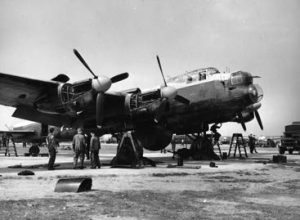 The men chosen to pilot the Lancasters were seasoned fliers: chief pilot Ken Souter had seen action in the Second World War as a Hurricane pilot in North Africa, while Joe Kmiecik, who was Polish, had flown Spitfires and Mustangs. Like his fellow countryman Ted Szuwalski, he had made a remarkable escape from a Soviet Gulag in 1941 and eventually arrived in England where he joined the RAF and learned to fly. Dick Lambert missed the war by a matter of months but was posted to a Lancaster squadron as a sergeant pilot.
The men chosen to pilot the Lancasters were seasoned fliers: chief pilot Ken Souter had seen action in the Second World War as a Hurricane pilot in North Africa, while Joe Kmiecik, who was Polish, had flown Spitfires and Mustangs. Like his fellow countryman Ted Szuwalski, he had made a remarkable escape from a Soviet Gulag in 1941 and eventually arrived in England where he joined the RAF and learned to fly. Dick Lambert missed the war by a matter of months but was posted to a Lancaster squadron as a sergeant pilot.
Usually it was only the pilots and engineers who were required to fly the Lancasters for filming duties, particularly if it was only on local flying, but for the longer trips a navigator was carried as well as additional crew members, such as air gunners and air signallers. Understandably there was never a shortage of people who wanted to hitch a ride in one of the Lancasters during the aerial filming sorties, such was the popular fascination at Hemswell and Scampton with the making of the film.
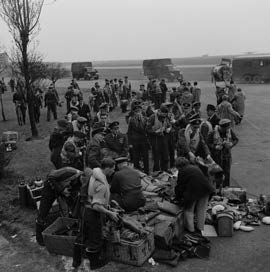 For Associated British it was an expensive business to lease the four Lancasters. The Air Ministry charged the company £100 per engine hour running time, and as there were usually three Lancasters, the Vickers Varsity camera aircraft and/ or the Vickers Wellington involved (3 x 4 engines and 2 x 2 engines), £1,600 per hour in the early 1950s was no small sum. Today this sum is roughly equivalent to £1,620 per engine hour, or £6,480 per Lancaster per hour. The total bill for the use of the four Lancasters and their crews would be an estimated £1.5 million at current prices.
For Associated British it was an expensive business to lease the four Lancasters. The Air Ministry charged the company £100 per engine hour running time, and as there were usually three Lancasters, the Vickers Varsity camera aircraft and/ or the Vickers Wellington involved (3 x 4 engines and 2 x 2 engines), £1,600 per hour in the early 1950s was no small sum. Today this sum is roughly equivalent to £1,620 per engine hour, or £6,480 per Lancaster per hour. The total bill for the use of the four Lancasters and their crews would be an estimated £1.5 million at current prices.
To make them resemble as closely as possible the actual Lancaster B Mk III (Type 464 Provisioning) aircraft that flew on the dam buster raid in 1943, three of the Mk 7s (NX673, NX679 and RT686) were specially modified at Hemswell by a working party from the A.V. Roe Repair Organisation at Bracebridge Heath. They had their mid-upper gun turrets (Glenn Martin Type 250 CE23), H2S radomes and bomb-bay doors removed to convert them to the authentic dambuster configuration. The bomb-bay itself was further modified to create the rebated aperture from which the mock-up of the bouncing bomb was suspended. However, the bomb itself was still on the secret list when the film was being made (it was only declassified in 1963), so the resulting mock-up bore little resemblance to the real thing. Made out of plywood and plaster of Paris, the slab-sided bouncing bomb mock-up for the film was somewhat larger in overall size than the real weapon, and deeper, which accentuated its shape and low-slung appearance for the benefit of the camera. The wooden replica was winched up into position in the bomb-bay recess and secured to the aircraft by bolts. Being firmly attached to the Lancaster’s belly, the replica bomb was never intended to be dropped.
Purists will notice a number of differences between wartime Lancasters and the Mk 7s that appear in the film. Perhaps the most obvious is the Frazer-Nash FN82 power-operated rear turret that was equipped with twin Browning .50-inch machine guns. In 1943, the Lancasters of 617 Squadron would have been fitted with FN20 rear turrets armed with four of the less-potent .303-inch Brownings. In addition, the series of small windows along each side of the fuselage that were a noticeable feature of wartime Lancasters were deleted from the post-war Mk 7. And note, too, the absence of the engine exhaust manifolds that would have been present on wartime Lancasters to reduce glare and suppress sparks from the hot exhausts at night.
The film aircraft wore different squadron code letters on either side of the fuselage, thereby enabling three Lancasters to play the parts of six on screen. NX679 was painted to represent Guy Gibson’s ED932 AJ-G and it was the only aircraft to have its serial number altered for the film. The other Lancasters retained their official RAF serials: NX673 was painted in the markings of Mick Martin’s P-Popsie (ED909 in 1943); one Lancaster, NX782, was retained as a standard Mk 7 and painted as ZN-G to represent Gibson’s aircraft when he commanded 106 Squadron, before being called upon to form 617 Squadron in March 1943; NX782 was the Lancaster that appears in the training flight flying sequences prior to Operation Chastise. There are some memorable moments in the film of this aircraft performing at extremely low level over Lake Windermere and the Derwent dam, skilfully flown by either Flt Sgt Joe Kmiecik or Flt Sgt Ted Szuwalski.
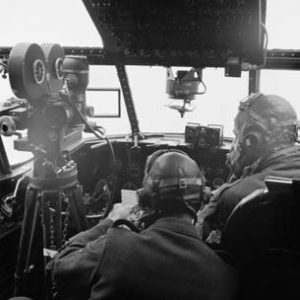 Other aircraft that had ‘walkon’ roles in the film were Vickers Wellington T10, MF628, and de Havilland Mosquito PR35, VR803. The Wellington appears briefly in the early part of the film taking off for a test air-drop of the mine, but most of the footage that purports to feature her is in fact archive film of a Wellington Mk II shot over Chesil Beach near Weymouth during the early tests of the actual prototype bouncing bombs in January 1943. Mosquito PR35, VR803, is seen briefly – and only – on the ground as the backdrop to test-pilot Mutt Summers after he has flown one of the trial weapondrop sorties. It is also linked to archive footage, showing a Mosquito B Mk IV testing the ‘Highball’ (anti-ship) bomb, although it purports to be a test-drop of an ‘Upkeep’ weapon, which it is not. In fact, the Mosquito was never used for testing ‘Upkeep’, nor did Mutt Summers ever fly a Mosquito for the purposes of testing the bomb.
Other aircraft that had ‘walkon’ roles in the film were Vickers Wellington T10, MF628, and de Havilland Mosquito PR35, VR803. The Wellington appears briefly in the early part of the film taking off for a test air-drop of the mine, but most of the footage that purports to feature her is in fact archive film of a Wellington Mk II shot over Chesil Beach near Weymouth during the early tests of the actual prototype bouncing bombs in January 1943. Mosquito PR35, VR803, is seen briefly – and only – on the ground as the backdrop to test-pilot Mutt Summers after he has flown one of the trial weapondrop sorties. It is also linked to archive footage, showing a Mosquito B Mk IV testing the ‘Highball’ (anti-ship) bomb, although it purports to be a test-drop of an ‘Upkeep’ weapon, which it is not. In fact, the Mosquito was never used for testing ‘Upkeep’, nor did Mutt Summers ever fly a Mosquito for the purposes of testing the bomb.
The Air Ministry put RAF Scampton at the disposal of Associated British as its base for the main shooting, which started early in April 1954, and a spell of good weather meant initially that filming could proceed unhindered. The second unit aerial filming was undertaken at a number of English locations that included the RAF airfields at Hemswell, Scampton, Kirton-in-Lindsey, Syerston and Silloth, and continued throughout the summer until its completion in mid- September. Most of the flying sequences were out of Hemswell during the week and from Scampton at the weekends, with the aircraft returning to Hemswell at the end of each day’s filming. The second unit film crew and its equipment was transported to Scampton and the other locations where it was required in an Airspeed Oxford or a Varsity.
Each time the Lancasters flew it was for some sort of filming activity: takeoffs, formation flying, low flying and landings, but the greater part of their flying was done in formation. Chief pilot Ken Souter recalled that as a team they didn’t really have any practice as such, but went more or less straight into the filming.
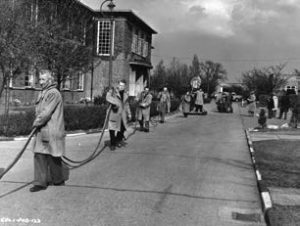 Flight engineer Mike Cawsey recalled how on the first of several familiarisation flights in a Lancaster during April 1954 he and pilot Ted Szuwalski practised lowlevel runs over the Derwent dam and lake, followed by some night flying when they used the ‘V’ landing lamps under the fuselage to cast converging beams on the water beneath them to establish their height at 60 feet – just as the 617 Squadron crews had done on the actual dams raid in 1943.
Flight engineer Mike Cawsey recalled how on the first of several familiarisation flights in a Lancaster during April 1954 he and pilot Ted Szuwalski practised lowlevel runs over the Derwent dam and lake, followed by some night flying when they used the ‘V’ landing lamps under the fuselage to cast converging beams on the water beneath them to establish their height at 60 feet – just as the 617 Squadron crews had done on the actual dams raid in 1943.
The weather across the British Isles in the summer of 1954 was far from ideal for filming. Low temperatures and a general lack of sunshine as well as heavy rainfall in many areas interrupted the aerial filming programme. Special Effects Photographer Gil Taylor remembered how the poor weather was a major hindrance for the second unit crew and did nothing to facilitate the aerial camera work. With aircraft fully fuelled and ready to fly, the air and film crews simply couldn’t sit and wait and hope for the weather to improve. They flew over the whole of southern England and up beyond Manchester to follow the clear weather and on at least one occasion they chased the sun over to Holland – in fact to wherever they could get some exposure for matching weather.
Scenes that recreated 617 Squadron’s training flights in England and Wales before Operation ‘Chastise’ (the codename for the dams raid) and the actual raids on the Ruhr dams themselves, were filmed over and along Lake Windermere in the Lake District, at the Derwent dam and reservoir in the Derbyshire Peak District, along the Lincolnshire and Suffolk coastlines, and over the west coast of Anglesey.
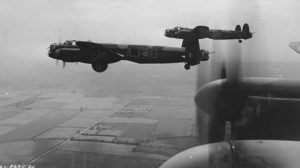 There were no power flying controls on the Lancaster so it required a high degree of physical fitness and effort on the part of the pilot to control and manoeuvre such a large aircraft, especially at low level. Pilot Ted Szuwalski recalled how on a number of occasions they flew at very low level in a threeship formation through the Kirkstone Pass in the Lake District towards Lake Windermere. The fine-tuning of their height above the ground and positioning relative to one another in flight was controlled through a radio link with the camera plane, and a radio operator working with a ground-based camera crew who were also filming the formation, but from below. There was, of course, direct radio communication between each of the Lancaster crews.
There were no power flying controls on the Lancaster so it required a high degree of physical fitness and effort on the part of the pilot to control and manoeuvre such a large aircraft, especially at low level. Pilot Ted Szuwalski recalled how on a number of occasions they flew at very low level in a threeship formation through the Kirkstone Pass in the Lake District towards Lake Windermere. The fine-tuning of their height above the ground and positioning relative to one another in flight was controlled through a radio link with the camera plane, and a radio operator working with a ground-based camera crew who were also filming the formation, but from below. There was, of course, direct radio communication between each of the Lancaster crews.
Sergeant Pilot Eric Quinney enthused about how flying for the film was the most exciting time in his twenty-odd years as an RAF pilot: ‘Being able to fly legally at a height of a mere 60 feet is exciting, but to do this in tight formation with some 30 tons of aircraft being controlled by one hand on the control column and one on the throttles really does get the adrenaline flowing. With three Lancasters in formation, each with a wingspan of over 100 feet, it is impressive but quite frightening when the lead aircraft starts to follow the prescribed route. One’s tendency is to edge away from the lead aircraft slightly as you feel he is going to slip down into you, but you can’t do that because in the banked turn you are much closer to the ground than 60 feet with your lower wingtip.’
Aircrew signaller James Fell described how low they actually flew at times: ‘A fair amount of filming went on at the Derwent reservoir with the Lancasters flying between the twin towers of the dam. After one filming sortie our ground crew reported on our return that we had bits of branches and leaves attached beneath the aircraft, so evidently we had clipped a tree.’
On the actual raid in 1943 the Lancasters of 617 Squadron were required to fly at a height of exactly 60 feet over the Ruhr dams to release their bouncing bombs. When this was re-created for the cameras of Associated British in 1954, 60 feet actually looked a lot higher on film when the rushes were viewed, so for much of the low level work Erwin Hillier asked Ken Souter and his crews to fly a lot lower, at 40 feet. Later, on at least one occasion, Ken flew low enough over the Derwent reservoir for the downdraught from his Lancaster’s four propellers to draw up individual waterspouts.
However, low-level and close formation flying was not without its dangers, as Gil Taylor confessed: ‘There were a few occasions during filming when we came close to disaster. Flying over Lake Windermere on one sortie, I gave the signal to turn to port and the camera Varsity responded which meant we gained height. The Lanc closest to us turned in towards us. We saw what was happening and our pilot dropped the Varsity like a stone until we picked up a bit of greenery and lost the port wingtip light. The Lanc went over the top, only just missing us.’
With the perils of low flying ever present in the minds of the men flying the Lancasters, they asked Associated British what would happen if a Lancaster was to crash during filming. ‘They said they would cancel the film,’ said James Fell.
Ken Souter described something of what was required on camera: ‘Windermere was quite simple to fly along, but flying across the lake was a different matter altogether. We had to come down a slope then flatten out across the lake and climb up over a mountain on the other side. This was quite hairy because there was not enough power to get up over the other side. We got quite a bit of flak from the yachting fraternity on Windermere for our low flying, though! Derwent was just a swoop down between the two towers and not as prolonged as Windermere.’
Once filming had been completed the four Lancasters that had helped to recreate the epic dam busters story were returned to storage in October 1954 at RAF Aston Down. Here they languished awhile until declared surplus to requirements and then, without ceremony, they were cut up and sold to the British Aluminium Co. in July 1956 to be melted down for scrap.
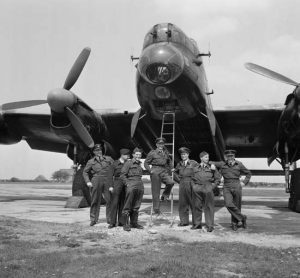 Ken Souter and his crews returned to their regular duties flying Lincolns as part of the RAF’s response to the escalating tensions in the Cold War between the West and the Soviet Union. The threat of a Third World War through nuclear confrontation was a very real and frightening possibility.
Ken Souter and his crews returned to their regular duties flying Lincolns as part of the RAF’s response to the escalating tensions in the Cold War between the West and the Soviet Union. The threat of a Third World War through nuclear confrontation was a very real and frightening possibility.
However, the last word on the contribution made to the film by Ken Souter and his crews must go to Richard Todd who said, ‘those RAF chaps in the film took a lot of chances and did a wonderful, wonderful job for us’.

